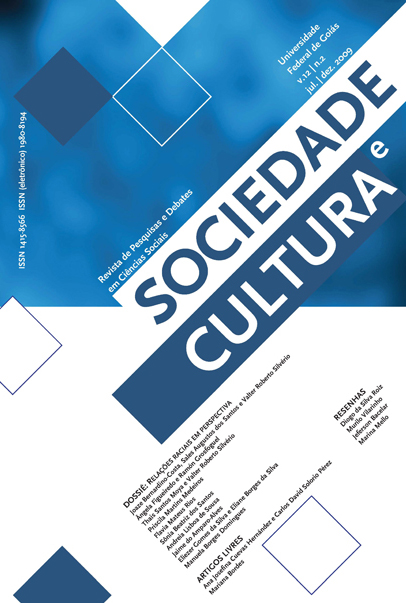Raza, género, clase, igualdad y justicia: representaciones simbólicas e ideológicas de la película Crash, de Paul Haggis
DOI:
https://doi.org/10.5216/sec.v12i2.5840Palabras clave:
racismo, antirracismo, género, clase, industria del entretenimientoResumen
Este ensayo examina la película Crash, de Paul Haggis, bajo la óptica de los estudios sobre las relaciones raciales. Emprende una lectura del simbólico e ideológico del metalenguaje de Crash (la forma como la historia es contada) y no del lenguaje ciertamente racista de sus personajes -el contenido explícito de la historia contada. Cotejando, con fidelidad, la moldura ficcional y discursiva de la película con los horizontes analíticos históricos y contemporáneos en el tema de las relaciones raciales -y sus correlaciones con las cuestiones de género, clase, igualdad y justicia-, el ensayo identifi ca el modo como Crash permite incorporar una subrepticia ideología racista -particularmente en el estereotipado y estigmatizante delineamiento moral de los personajes negros, comparativamente a los personajesblancos-, bajo el manto de protección de una película que aparentemente propone combatir el racismo. Crash sería, en el argumento del ensayo, un típico ejemplo -de ficción y de realidad- del que se denomina por “antirracismo racista”. Al final, el ensayo llama la atención para la responsabilidad social y ética de la industria del entretenimiento y su compatibilidad con la libertad de creación artística.Descargas
Los datos de descargas todavía no están disponibles.
Descargas
Publicado
2010-03-18
Cómo citar
SILVA, ELIEZER GOMES DA; SILVA, ELIANE BORGES DA. Raza, género, clase, igualdad y justicia: representaciones simbólicas e ideológicas de la película Crash, de Paul Haggis. Sociedade e Cultura, Goiânia, v. 12, n. 2, p. 311–324, 2010. DOI: 10.5216/sec.v12i2.5840. Disponível em: https://revistas.ufg.br/fcs/article/view/5840. Acesso em: 8 dic. 2025.
Número
Sección
Dossiê
Licencia
Autores/as que publican en esta revista están de acuerdo con los siguientes términos:
- Autores/as mantienen los derechos autorales y ceden a la revista el derecho de primera publicación, siendo el trabajo simultáneamente licenciado por la Creative Commons Attribution License, lo que permite el compartir del trabajo con reconocimiento de autoría y de la publicación inicial en esta revista;
- Autores/as tienen autorización para asumir contratos adicionales separadamente, para distribución no exclusiva de la versión del trabajo publicada en esta revista (ejemplo: publicar en repositorio institucional o como capítulo de libro), con reconocimiento de autoría y de la publicación inicial en esta revista;
- Autores/as tienen permiso y son estimulados/as a publicar y a distribuir su trabajo en la web (ejemplo: en repositorios institucionales o en su página personal) a cualquier punto antes o durante el proceso editorial, ya que eso puede tener alteraciones productivas, así como aumentar el impacto y la cita del trabajo publicado (véase O Efeito do Acesso Livre).



